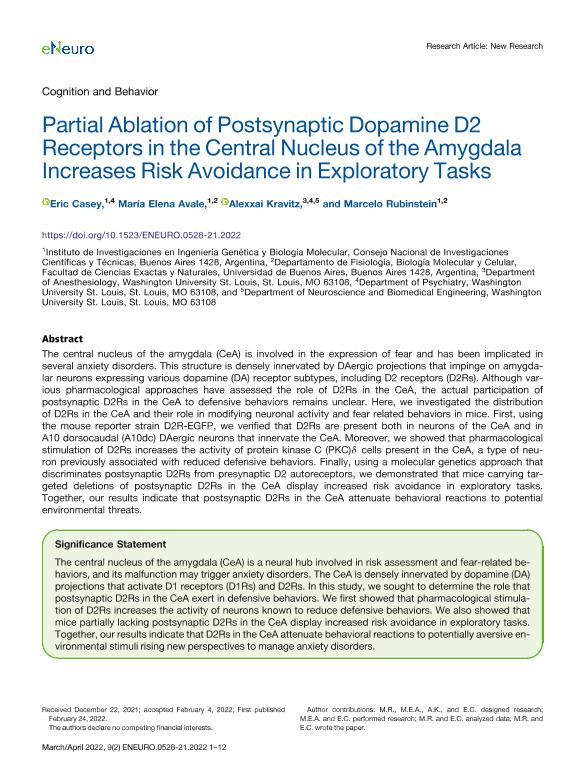Mostrar el registro sencillo del ítem
dc.contributor.author
Casey, Eric

dc.contributor.author
Avale, Maria Elena

dc.contributor.author
Kravitz, Alexxai
dc.contributor.author
Rubinstein, Marcelo

dc.date.available
2023-06-26T11:02:22Z
dc.date.issued
2022-02-24
dc.identifier.citation
Casey, Eric; Avale, Maria Elena; Kravitz, Alexxai; Rubinstein, Marcelo; Partial ablation of postsynaptic dopamine D2 receptors in the central nucleus of the amygdala increases risk avoidance in exploratory tasks; Society for Neuroscience; eNeuro; 9; 2; 24-2-2022; 1-12
dc.identifier.uri
http://hdl.handle.net/11336/201406
dc.description.abstract
The central nucleus of the amygdala (CeA) is involved in the expression of fear and has been implicated in several anxiety disorders. This structure is densely innervated by DAergic projections that impinge on amygdalar neurons expressing various dopamine (DA) receptor subtypes, including D2 receptors (D2Rs). Although various pharmacological approaches have assessed the role of D2Rs in the CeA, the actual participation of postsynaptic D2Rs in the CeA to defensive behaviors remains unclear. Here, we investigated the distribution of D2Rs in the CeA and their role in modifying neuronal activity and fear related behaviors in mice. First, using the mouse reporter strain D2R-EGFP, we verified that D2Rs are present both in neurons of the CeA and in A10 dorsocaudal (A10dc) DAergic neurons that innervate the CeA. Moreover, we showed that pharmacological stimulation of D2Rs increases the activity of protein kinase C (PKC)δ cells present in the CeA, a type of neuron previously associated with reduced defensive behaviors. Finally, using a molecular genetics approach that discriminates postsynaptic D2Rs from presynaptic D2 autoreceptors, we demonstrated that mice carrying targeted deletions of postsynaptic D2Rs in the CeA display increased risk avoidance in exploratory tasks. Together, our results indicate that postsynaptic D2Rs in the CeA attenuate behavioral reactions to potential environmental threats.
dc.format
application/pdf
dc.language.iso
eng
dc.publisher
Society for Neuroscience
dc.rights
info:eu-repo/semantics/openAccess
dc.rights.uri
https://creativecommons.org/licenses/by-nc-sa/2.5/ar/
dc.subject
AMIGDALA
dc.subject
DOPAMINA
dc.subject
RECEPTOR D2
dc.subject
LENTIVIRUS
dc.subject.classification
Bioquímica y Biología Molecular

dc.subject.classification
Ciencias Biológicas

dc.subject.classification
CIENCIAS NATURALES Y EXACTAS

dc.title
Partial ablation of postsynaptic dopamine D2 receptors in the central nucleus of the amygdala increases risk avoidance in exploratory tasks
dc.type
info:eu-repo/semantics/article
dc.type
info:ar-repo/semantics/artículo
dc.type
info:eu-repo/semantics/publishedVersion
dc.date.updated
2023-06-22T10:21:48Z
dc.identifier.eissn
2373-2822
dc.journal.volume
9
dc.journal.number
2
dc.journal.pagination
1-12
dc.journal.pais
Estados Unidos

dc.journal.ciudad
Washington
dc.description.fil
Fil: Casey, Eric. Consejo Nacional de Investigaciones Científicas y Técnicas. Instituto de Investigaciones en Ingeniería Genética y Biología Molecular "Dr. Héctor N. Torres"; Argentina. Washington University in St. Louis; Estados Unidos
dc.description.fil
Fil: Avale, Maria Elena. Consejo Nacional de Investigaciones Científicas y Técnicas. Instituto de Investigaciones en Ingeniería Genética y Biología Molecular "Dr. Héctor N. Torres"; Argentina. Universidad de Buenos Aires. Facultad de Ciencias Exactas y Naturales. Departamento de Fisiología, Biología Molecular y Celular; Argentina
dc.description.fil
Fil: Kravitz, Alexxai. Washington University in St. Louis; Estados Unidos
dc.description.fil
Fil: Rubinstein, Marcelo. Consejo Nacional de Investigaciones Científicas y Técnicas. Instituto de Investigaciones en Ingeniería Genética y Biología Molecular "Dr. Héctor N. Torres"; Argentina. Universidad de Buenos Aires. Facultad de Ciencias Exactas y Naturales. Departamento de Fisiología, Biología Molecular y Celular; Argentina
dc.journal.title
eNeuro
dc.relation.alternativeid
info:eu-repo/semantics/altIdentifier/url/https://www.eneuro.org/lookup/doi/10.1523/ENEURO.0528-21.2022
dc.relation.alternativeid
info:eu-repo/semantics/altIdentifier/doi/http://dx.doi.org/10.1523/ENEURO.0528-21.2022
Archivos asociados
